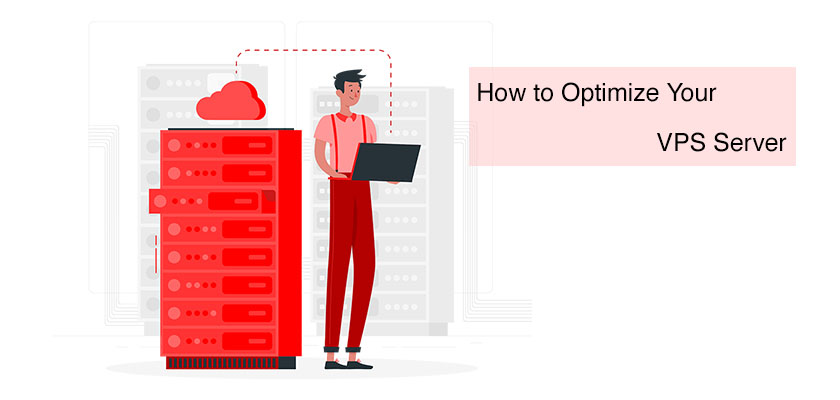
In conjunction with your website’s steady growth, the VPS is a crucial element in accelerating your performance. After a certain time, your VPS could be operating indefinitely; however, to ensure you get the best performance, you must adhere to a set of dynamic methods to optimize VPS hosting server.
You can buy optimized VPS hosting server or optimize a VPS hosting server on your own, as it’s always a positive signal to an individual to make their work experience more quickly than it was previously. In this article, we’d be discussing how to optimize a VPS hosting server for Linux as well as Windows. Be aware that certain options for VPS optimizations could require some technical know-how.
What Is VPS Hosting Server?
VPS (Virtual Private Server) is the kind of web hosting with the capacity to house an entire website. This kind of organizing web server can provide extraordinary resources like RAM, disk space, and CPU cores. Additionally, users can manage multiple websites from one server with unlimited source capabilities. Therefore, when you plan to purchase an efficient VPS hosting server, it is essential to look at the different options accessible to you.
What Is the Reason VPS Hosting Optimization Is Essential?
Optimization comes with specific advantages and advantages for users and the site. It is crucial to ensure a reliable page speed as well as the security of your website. No matter if your site has a high-speed efficiency and has no technical issues, you have to give top priority to optimizing. We’ll discuss the best ways to optimize VPS hosting.
How To Optimize Linux VPS
As mentioned above, you can optimize your VPS on Linux and Windows operating systems by taking certain steps. We will present each suggestion and technique related to the “Optimize VPS hosting server” issue in this section.
Based on the preference of the user, Linux VPS is operated in two specific zones. Two areas include:
- CentosOS
- Ubuntu
How to Optimize Linux VPS (CentOS)
CentOS operating system of Linux is now an extremely popular OS today. It is renowned for its area-based commercial operating system. In order to optimize software and servers for data, the admin panel will always comply with custom-designed efficiency adjustments made with various tools. Tuned is regarded to be one of the best tools for adjusting performance amongst CentOS users.
Tuned is not able to dynamically alter the structures of the system. If you want to modify Tuned, it is essential to be aware of how the powerful daemon functions and permit it to alter several settings based on system use.
By customizing the Tuned account, you will be able to permit creating a custom-made account, and by doing this, you will be able to increase the performance of your application. Tuned profiles are divided into two distinct categories. These are:
- Profiles to boost performance
- Profiles that save energy
The accounts that boost performance emphasize certain essential aspects:
- Storage and network
- High throughput storage and network
- Virtual machine performance
- Virtualization Host performance
Set Up Tuned on CentOS.
We’ll walk you through the process of installing adjusted on CentOS and how to design custom-made adjusting profiles.
Adhere to Yum Command
Keep in mind that Tuned is installed and activated as default; however, in the old version of CentOs, it’s necessary to configure Tuned by using the following command:
#yum install tuned
After installing, you’ll be able to examine some of the important files that need to be attached:
- /etc/tuned – tuned configuration directory.
- /etc/tuned/tuned-main.conf – tuned mail configuration file.
- /usr/lib/tuned/ – save a sub-directory for all profiles of tuning.
Manage The Tuned Efficiency
It is easy to handle the tuning performance service using these commands:
#systemctl start tuned
#systemctl enable tuned
#systemctl status tuned
#systemctl stop tuned
Control the Establishing Utilizing the Tuned-adm Tool
Once you’ve done that, you’ll be able to control over-tuned using the tuned-adm program. It is recommended to examine the current profile using one of the commands below. But keep in mind that there are plenty of predefined adjusting accounts being used in basic circumstances.
#tuned-adm active
Running as a Virtual Guest
In accordance with the results of the discussion command, the virtual visitor system is an enhancement of the test system.
Get A Listing of Profiles
In the next step, you’ll be able to see a list of accessible profiles by using the following command:
#tuned-adm list
Move Any Type of Profiles on Common Server Lots
After you’ve got this list of accounts, you can switch to any account that is available by using these commands:
#tuned-adm profile throughput-performance
#tuned-adm active
Use The Recommended Profile
In this section, if you want to utilize the account that you have been advised to use for your system, you can use these commands:
#tuned-adm recommend
Disable The Settings
In the last thought component, you can deactivate any adjusting settings using entering the command below:
#tuned-adm off
Create Customized Tuning Profile
You can design a personal tuning profile by following a few fundamental techniques. Another method is to maximize the efficiency of VPS in CentOs. Keep in mind that the style makes use of the latest latency performance settings.
- Enter the route right away that combines sub-directories for all tuning profiles.
- Then, create the test-performance subdirectory to store your customized tuning profile
#cd /usr/lib/tuned/
#mkdir test-performance
- It’s time to make a tuned.conf configuration within the directory. For the final step, you can use the following command:
#vim test-performance/tuned.conf
- After you’ve completed the previous task, you should now copy and paste the code below:
[main]
Include=latency-performance
Summary = Test profile that utilizes settings to
Latency-performance tuning profile
- In the end, you’ll be able to activate the brand new tuned profile by using the following command:
#tuned-adm profile test-performance
How to Optimize Linux VPS (Ubuntu)
Keep Ubuntu up to date
Ubuntu has gained a large following all over the world and strives to improve its performance. Updates to Ubuntu are released two times a year, and they include significant changes.
Be sure that your Ubuntu is updated whenever new updates are made available. This will allow you to make the most effective use of the capabilities of your OS. To look for recent updates, use the instructions below:
sudo apt-get update
If you’re in search of an original version of Ubuntu, then:
sudo apt-get upgrade
Make sure to backup all your files prior to making changes.
Upgrade Your Storage devices
SSDs are more expensive than HDD or flash drives. They give you greater security and protection of your data over HDD and flash drives. They’ll definitely provide you with the fastest data transfer speed than other storage devices on the disk. If you want to maximize the performance of the VPS server hosting, then we highly recommend that you use SSD to install Ubuntu.
It is also possible to add more RAM to your system to help make Ubuntu run more smoothly. A quick tip here: Ubuntu requires a minimum of 2GB of RAM for it to function efficiently. Additionally, not every type of RAM will improve the performance of the device. Also, review your device’s version and the type of RAM that is the best for your machine. If you’d like to check the type of RAM and the rate of memory, enter your command below:
sudo lshw -c memory
If you’re looking to find the amount of RAM in Ubuntu, you can do so by using this command to check:
Free -m
Free Disk Room
The speed of performance of Ubuntu is in part dependent on the amount of space that is left on the HDD. The more data remains on the disk and the greater the likelihood that the OS requires time to refine its information. This means that you can improve the performance of Ubuntu OS by clearing some space from the hard disk.
There’s a simple method to get rid of the cache in the OS. Enter:
sudo apt-get clean
If you wish to remove the additional bundles and dependencies, enter this command into your Ubuntu terminal:
sudo apt-get autoremove
Mount Preloads
The principal goal of “preloading tasks” is to save the necessary files in RAM. This function runs in the background as well as analyzes your most used applications, resulting in the fastest performance than simply putting the files on your hard drive.
Preloading will definitely assist the system in understanding the applications you must load to launch the OS. This can help in reducing the time it takes to start up and increase the speed of performance of the operating system. If you want to install preload on an Ubuntu system, simply use this command:
sudo apt-get install preload
Once the installation is completed then, restart the system. From this point on, the preload will be running in the background every time you start your machine.
Control Start-up Programs
As we’ve previously discussed, the more software that you add to your operating system, the more information your system has to process and the slower the speed of your OS. Ubuntu comes with a particular program known as “Start-up Applications.” It can be accessed by navigating to the GNOME directory. You can also review the services launched within Ubuntu (18.04) using this command
Service -status-all
If you wish to end an individual service running on your computer, enter this command:
sudo service <name> stop
You can also delete the program that you don’t need by following this command:
sudo apt-get remove <name>
Make use of Local Mirrors
To get the most from the system’s efficiency, there are many Ubuntu software repositories mirroring across the globe. It is essential to ensure that you select an alternative mirror close to your area when you upgrade the software because how close in relation to the mirror, the speedier the downloads and updates will be.
If you’re interested in picking the mirror that is closest to you, Follow these steps:
- Go to Software.
- Select the Menu button (top left on the webpage).
- Select Software and Updates.
- On the Ubuntu Software tab, choose “Download from.”
- Select Other
- Choose the closest server to you.
Tips: “Real-time” install option in the file etc/fstab
In accordance with the POSIX standards, every operating system maintains metadata for the file system that tracks the date and time for any file last accessed or modified, or altered. So, whenever you are reading/writing/accessing a file, the system needs to determine the time and store it somewhere.
This causes a bit of work on the system and can affect the performance of the VPS. You can alter this behavior and optimize VPS hosting server using the “relatime” mount option “relatime” mount option in /etc/fstab
If you are looking to use the relatime option, enter this command:
/dev/sda1/mount-point ext4 defaults.relatime 0 0
How to Optimize Windows VPS
Update Windows
If you are looking to optimize Windows VPS performance, You must ensure that you keep your Windows OS up-to-date. Many of the Windows updates don’t make major technical changes to the operating system. It’s an excellent idea to keep your Windows up-to-date with the technical and necessary updates.
Some of the home windows updates are optional, and others are required. It is possible to skip the ones that are not required but make sure to check your Windows to ensure security and safety updates, new feature updates, and OS updates. This will surely assist you in improving the efficiency of your VPS Windows.
Updates to the Windows OS will improve the efficiency of your VPS, but it also helps to make your system more secure from cyber-attacks. Always make sure to keep your Windows OS up-to-date.
Get Rid of Unnecessary Programs
Windows is an extremely versatile operating system that can be used in a variety of ways. There are many possibilities to do by using Windows to run an OS on your VPS. But there are many applications that you won’t use. As we have discussed before, the more functions the OS is able to provide; the more complex the process will be. To boost the VPS effectiveness for your Windows OS, try:
- Close system tray program programs
- Stop unnecessary software that is not needed for the startup
- Shut down and locate applications that eat resources
- Remove programs that you don’t need
- Turn off additional Windows features
Remove Unnecessary Files
The server space for web servers is restricted. If you save unwanted data on the server, it can increase the load on your operating system and hinder the VPS performance. It is the ideal option to identify and eliminate any unnecessary data that could take up space on the server.
It is possible to use a disk cleanup program to locate and delete files that aren’t needed, and you can also find the files manually and erase them. While it might not feel like much, clearing the server’s storage space can improve the efficiency of your VPS in a substantial way.
Check for Malware
Another issue that can eat the valuable resources of your web server is malware. They take up not just the space of your server, but they can also pose a security risk for the entire server. You can use Malware removal tools to get rid of all malware hidden within your system.
If you are using the server as a PC, there is a high chance that the server will be infected with many Malwares. Try to avoid doing this. Be aware of the person who will get access to the server’s administrative rights. If a computer with the infection connects to the server, it may propagate the infection, which could hinder the VPS performance.
Conclusion
In this post, we talked about how to optimize the VPS hosting server. Prior to buying optimized VPS hosting server, make sure to examine the options and features as well as the hosting company’s own features.










Leave a Reply